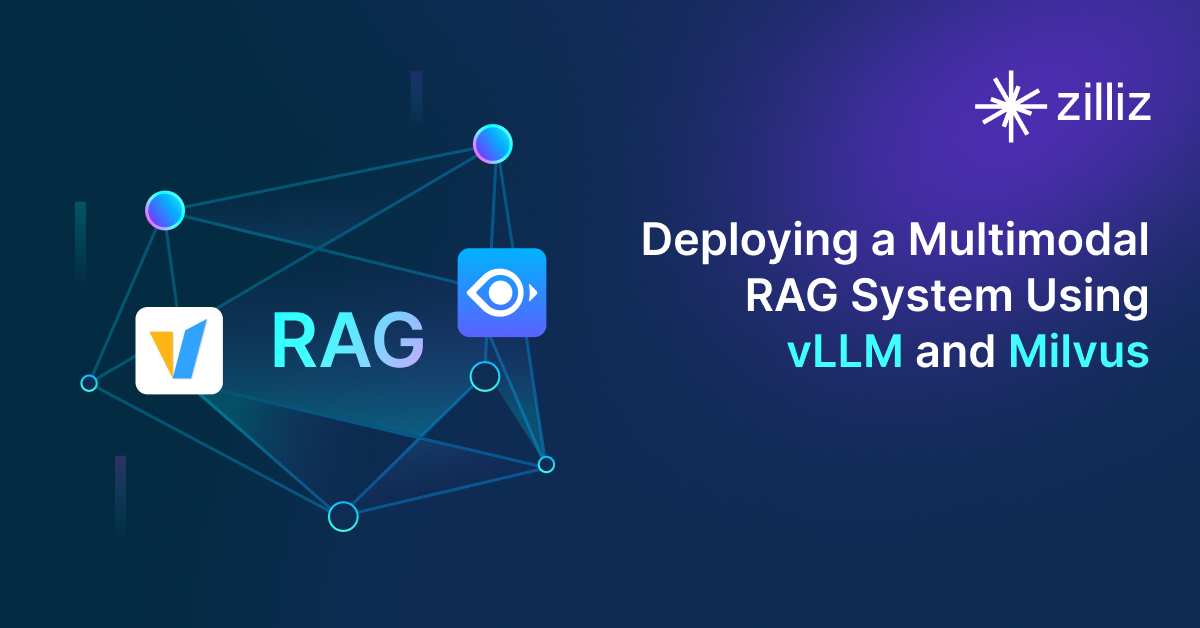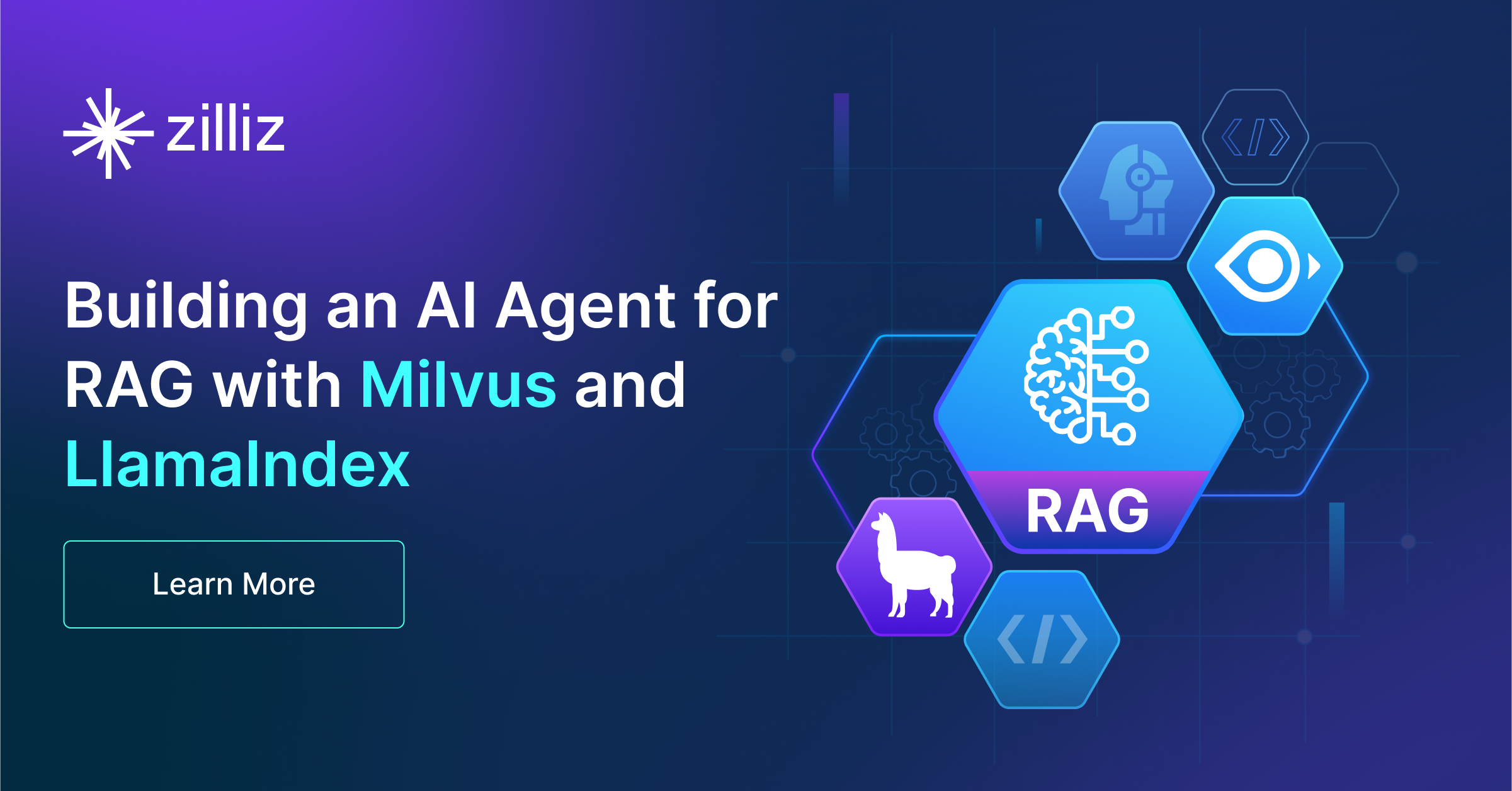Build RAG Chatbot with LangChain, LangChain vector store, NVIDIA Deepseek R1, and Google Vertex AI text-embedding-005
Introduction to RAG
Retrieval-Augmented Generation (RAG) is a game-changer for GenAI applications, especially in conversational AI. It combines the power of pre-trained large language models (LLMs) like OpenAI’s GPT with external knowledge sources stored in vector databases such as Milvus and Zilliz Cloud, allowing for more accurate, contextually relevant, and up-to-date response generation. A RAG pipeline usually consists of four basic components: a vector database, an embedding model, an LLM, and a framework.
Key Components We'll Use for This RAG Chatbot
This tutorial shows you how to build a simple RAG chatbot in Python using the following components:
- LangChain: An open-source framework that helps you orchestrate the interaction between LLMs, vector stores, embedding models, etc, making it easier to integrate a RAG pipeline.
- LangChain in-memory vector store: an in-memory, ephemeral vector store that stores embeddings in-memory and does an exact, linear search for the most similar embeddings. The default similarity metric is cosine similarity, but can be changed to any of the similarity metrics supported by ml-distance. It is intended for demos and does not yet support ids or deletion. (If you want a much more scalable solution for your apps or even enterprise projects, we recommend using Zilliz Cloud, which is a fully managed vector database service built on the open-source Milvusand offers a free tier supporting up to 1 million vectors.)
- NVIDIA Deepseek R1: This advanced AI model is designed for high-fidelity image synthesis and enhancement, leveraging NVIDIA’s cutting-edge graphics technology. With its ability to generate realistic visuals and improve image quality, Deepseek R1 is ideal for applications in gaming, film production, and virtual reality, where lifelike graphics are paramount.
- Google Vertex AI text-embedding-005: This model produces high-quality text embeddings, facilitating nuanced semantic understanding and similarity comparisons. Its strength lies in efficiency and scalability, making it ideal for tasks like information retrieval, recommendation systems, and multi-language support. Perfect for developers seeking to enhance their applications with powerful contextual insights.
By the end of this tutorial, you’ll have a functional chatbot capable of answering questions based on a custom knowledge base.
Note: Since we may use proprietary models in our tutorials, make sure you have the required API key beforehand.
Step 1: Install and Set Up LangChain
%pip install --quiet --upgrade langchain-text-splitters langchain-community langgraph
Step 2: Install and Set Up NVIDIA Deepseek R1
pip install -qU "langchain-nvidia-ai-endpoints"
import getpass
import os
if not os.environ.get("NVIDIA_API_KEY"):
os.environ["NVIDIA_API_KEY"] = getpass.getpass("Enter API key for NVIDIA: ")
from langchain.chat_models import init_chat_model
llm = init_chat_model("deepseek-ai/deepseek-r1", model_provider="nvidia")
Step 3: Install and Set Up Google Vertex AI text-embedding-005
pip install -qU langchain-google-vertexai
from langchain_google_vertexai import VertexAIEmbeddings
embeddings = VertexAIEmbeddings(model="text-embedding-005")
Step 4: Install and Set Up LangChain vector store
pip install -qU langchain-core
from langchain_core.vectorstores import InMemoryVectorStore
vector_store = InMemoryVectorStore(embeddings)
Step 5: Build a RAG Chatbot
Now that you’ve set up all components, let’s start to build a simple chatbot. We’ll use the Milvus introduction doc as a private knowledge base. You can replace it with your own dataset to customize your RAG chatbot.
import bs4
from langchain import hub
from langchain_community.document_loaders import WebBaseLoader
from langchain_core.documents import Document
from langchain_text_splitters import RecursiveCharacterTextSplitter
from langgraph.graph import START, StateGraph
from typing_extensions import List, TypedDict
# Load and chunk contents of the blog
loader = WebBaseLoader(
web_paths=("https://milvus.io/docs/overview.md",),
bs_kwargs=dict(
parse_only=bs4.SoupStrainer(
class_=("doc-style doc-post-content")
)
),
)
docs = loader.load()
text_splitter = RecursiveCharacterTextSplitter(chunk_size=1000, chunk_overlap=200)
all_splits = text_splitter.split_documents(docs)
# Index chunks
_ = vector_store.add_documents(documents=all_splits)
# Define prompt for question-answering
prompt = hub.pull("rlm/rag-prompt")
# Define state for application
class State(TypedDict):
question: str
context: List[Document]
answer: str
# Define application steps
def retrieve(state: State):
retrieved_docs = vector_store.similarity_search(state["question"])
return {"context": retrieved_docs}
def generate(state: State):
docs_content = "\n\n".join(doc.page_content for doc in state["context"])
messages = prompt.invoke({"question": state["question"], "context": docs_content})
response = llm.invoke(messages)
return {"answer": response.content}
# Compile application and test
graph_builder = StateGraph(State).add_sequence([retrieve, generate])
graph_builder.add_edge(START, "retrieve")
graph = graph_builder.compile()
Test the Chatbot
Yeah! You've built your own chatbot. Let's ask the chatbot a question.
response = graph.invoke({"question": "What data types does Milvus support?"})
print(response["answer"])
Example Output
Milvus supports various data types including sparse vectors, binary vectors, JSON, and arrays. Additionally, it handles common numerical and character types, making it versatile for different data modeling needs. This allows users to manage unstructured or multi-modal data efficiently.
Optimization Tips
As you build your RAG system, optimization is key to ensuring peak performance and efficiency. While setting up the components is an essential first step, fine-tuning each one will help you create a solution that works even better and scales seamlessly. In this section, we’ll share some practical tips for optimizing all these components, giving you the edge to build smarter, faster, and more responsive RAG applications.
LangChain optimization tips
To optimize LangChain, focus on minimizing redundant operations in your workflow by structuring your chains and agents efficiently. Use caching to avoid repeated computations, speeding up your system, and experiment with modular design to ensure that components like models or databases can be easily swapped out. This will provide both flexibility and efficiency, allowing you to quickly scale your system without unnecessary delays or complications.
LangChain in-memory vector store optimization tips
LangChain in-memory vector store is just an ephemeral vector store that stores embeddings in-memory and does an exact, linear search for the most similar embeddings. It has very limited features and is only intended for demos. If you plan to build a functional or even production-level solution, we recommend using Zilliz Cloud, which is a fully managed vector database service built on the open-source Milvus and offers a free tier supporting up to 1 million vectors.)
NVIDIA Deepseek R1 optimization tips
To optimize the NVIDIA Deepseek R1 for Retrieval-Augmented Generation (RAG), ensure that your input data is well-prepared and indexed for fast access, leveraging its caching capabilities. Utilize mixed-precision training to enhance performance while reducing memory usage, and experiment with different batch sizes to find the most efficient processing speed. Additionally, regularly monitor and fine-tune hyperparameters such as learning rate and dropout rates based on validation results to avoid overfitting. Implement asynchronous data loading to keep the GPU actively processing while managing I/O operations. Finally, streamline the architecture by pruning non-essential layers and optimizing the model's inference pipeline to enhance real-time retrieval performance.
Google Vertex AI text-embedding-005 optimization tips
Google Vertex AI text-embedding-005 is a high-performing model, optimized for generating context-aware embeddings in RAG systems. Improve retrieval accuracy by leveraging a two-stage search process: first, filter using keyword matching, then re-rank results based on embedding similarity. Use batch embedding generation to minimize latency and streamline processing. When managing large datasets, implement hierarchical vector indexing to optimize memory usage and retrieval speed. Fine-tune embeddings with domain-specific data to improve retrieval relevance for niche use cases. For high-throughput systems, employ a distributed search infrastructure to scale efficiently while maintaining low query response times. Regularly evaluate the embeddings’ relevance and update the model with new training data for optimal performance.
By implementing these tips across your components, you'll be able to enhance the performance and functionality of your RAG system, ensuring it’s optimized for both speed and accuracy. Keep testing, iterating, and refining your setup to stay ahead in the ever-evolving world of AI development.
RAG Cost Calculator: A Free Tool to Calculate Your Cost in Seconds
Estimating the cost of a Retrieval-Augmented Generation (RAG) pipeline involves analyzing expenses across vector storage, compute resources, and API usage. Key cost drivers include vector database queries, embedding generation, and LLM inference.
RAG Cost Calculator is a free tool that quickly estimates the cost of building a RAG pipeline, including chunking, embedding, vector storage/search, and LLM generation. It also helps you identify cost-saving opportunities and achieve up to 10x cost reduction on vector databases with the serverless option.
 Calculate your RAG cost
Calculate your RAG cost
What Have You Learned?
By diving into this tutorial, you’ve unlocked the magic of building a RAG system from the ground up! You learned how LangChain acts as the glue, seamlessly connecting your pipeline components while handling workflow orchestration. The LangChain Vector Store stepped in as your data powerhouse, organizing and retrieving information with lightning-fast precision. NVIDIA’s DeepSeek R1, your powerhouse LLM, transformed those retrieved snippets into human-like, context-aware responses, showcasing its knack for understanding nuance. And let’s not forget Google’s text-embedding-005 model—your secret sauce for turning raw text into rich numerical representations, making every query and document truly machine-readable. Together, these tools formed a dynamic quartet, proving how RAG bridges the gap between static data and intelligent, adaptive AI systems. You even got hands-on with pro tips like optimizing chunk sizes for efficiency and balancing speed with accuracy in retrieval—skills that’ll save you time and headaches down the road!
But wait, there’s more! You discovered how to future-proof your projects using the free RAG cost calculator to estimate expenses and scale smarter. Imagine the possibilities: chatbots that answer like experts, search tools that feel psychic, or personalized content generators that wow users. This tutorial wasn’t just about code—it was about empowering you to innovate. So, what’s next? Take these building blocks, tweak the parameters, add your own data, and watch your ideas come alive. The world of RAG is yours to explore, optimize, and redefine. Ready to turn “what if” into “what’s next”? Start building, experiment fearlessly, and let your creativity run wild—you’ve got all the tools to make it happen! 🚀
Further Resources
🌟 In addition to this RAG tutorial, unleash your full potential with these incredible resources to level up your RAG skills.
- How to Build a Multimodal RAG | Documentation
- How to Enhance the Performance of Your RAG Pipeline
- Graph RAG with Milvus | Documentation
- How to Evaluate RAG Applications - Zilliz Learn
- Generative AI Resource Hub | Zilliz
We'd Love to Hear What You Think!
We’d love to hear your thoughts! 🌟 Leave your questions or comments below or join our vibrant Milvus Discord community to share your experiences, ask questions, or connect with thousands of AI enthusiasts. Your journey matters to us!
If you like this tutorial, show your support by giving our Milvus GitHub repo a star ⭐—it means the world to us and inspires us to keep creating! 💖
- Introduction to RAG
- Key Components We'll Use for This RAG Chatbot
- Step 1: Install and Set Up LangChain
- Step 2: Install and Set Up NVIDIA Deepseek R1
- Step 3: Install and Set Up Google Vertex AI text-embedding-005
- Step 4: Install and Set Up LangChain vector store
- Step 5: Build a RAG Chatbot
- Optimization Tips
- RAG Cost Calculator: A Free Tool to Calculate Your Cost in Seconds
- What Have You Learned?
- Further Resources
- We'd Love to Hear What You Think!
Content
Vector Database at Scale
Zilliz Cloud is a fully-managed vector database built for scale, perfect for your RAG apps.
Try Zilliz Cloud for Free


